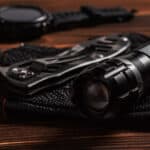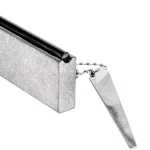Emergency signaling techniques play a crucial role in community survival during crises. These methods, which include visual, auditory, ground, and electronic signals like signal mirrors, whistles, and satellite messengers, are lifesavers.
They help save lives by making rescuers aware of your location. Time is critical in emergencies; fast communication reduces anxiety and can mean the difference between life and death.
Modern technology offers advanced tools such as personal locator beacons (PLBs), Garmin inReach satellite messengers, and apps for sending distress messages directly to rescuers. Knowing how to use natural materials to create visible signals for aircraft or using whistles that carry sound far can catch a rescuer’s attention effectively.
It’s essential to prepare by choosing the right signaling tools and letting people know your travel plans. Using these signals correctly avoids false alarms so real emergencies get the attention they need—learning international distress symbols and visibility techniques aids in getting rescued from different situations.
Let’s explore how to get noticed when you need it most.
Table of Contents
Importance of Signaling for Help
Signaling for help can save your life. It cuts down on worry and makes rescue teams find you faster.
Saving lives
Quick and correct signaling can save lives. It makes a huge difference in emergency situations. Using a signal mirror, lighting a fire, or sending an S.O.S. with Morse code can catch rescuers’ attention fast.
These signals let people know you need help right away.
Knowing what signal to use is important, too. A personal locator beacon works best in remote areas, while smoke signals are good for open spaces like forests or deserts. Each method sends a clear call for help, guiding rescue teams to your location quickly.
This cuts down on the time you’re in danger and ups your chances of getting out safely.
Reducing anxiety
Knowing how to signal for help not only saves lives but also cuts down on worry. Being ready with the right tools and knowing what to do can calm you in tough times. Effective signaling gives hope and makes it less scary when things go wrong.
This means having flares, radios, or even making fires to catch rescuers’ attention can ease your mind, letting you focus on getting found.
Having these tools and understanding local rules keep you safe outdoors. It’s like having a backup plan that talks for you when you need it most. This reduces panic by reassuring everyone involved that help is on the way – making each moment a step closer to safety rather than fear.
Importance of time in emergencies
After reducing anxiety, we see how vital time is in emergencies. Every second counts when someone’s life hangs in the balance. Quick help can prevent bad situations from getting worse.
This means sending a distress signal fast might save a life or avoid severe injury.
Using the right signals — like smoke for visibility during the day or light sticks at night — helps rescuers find people quicker. Time lost can lead to tragedy, especially if medical help is needed right away.
In these moments, tools like an AN/PRC-112 survival radio become lifelines, allowing for speedy communication with rescue teams.
Establish a Communication Plan
Before venturing into the wilderness, it is essential to establish a communication plan and let others know your intended route, destination, and expected return time. This proactive step can greatly increase your chances of being found quickly in case of an emergency.
Start by thoroughly researching your planned route and familiarizing yourself with the area. Note any potential hazards, water sources, and landmarks that could serve as reference points. Share this information and a detailed itinerary with a trusted friend, family member, or local authorities before departing.
When creating your communication plan, consider the following:
- Provide a clear description of your intended route, including any planned deviations or side trips.
- Estimate your expected return time and establish a time frame after which your designated contact should notify authorities if you haven’t returned or checked in.
- If possible, carry a communication device such as a satellite messenger or personal locator beacon (PLB) that allows you to send updates and emergency signals even in areas without cell phone reception.
- Regularly update your designated contact on your progress and any changes to your plans, if possible.
- Upon returning from your trip, promptly inform your contact to avoid unnecessary worry or initiation of search and rescue efforts.
By establishing a clear communication plan and keeping others informed of your whereabouts, you create a safety net for yourself in case of unexpected emergencies.
If you find yourself lost or in need of assistance, having a well-informed support netw
Universal Distress Signals
When faced with an emergency situation in the wilderness, it is crucial to know and use the internationally recognized distress signals to maximize your chances of being rescued. One of the most important universal distress signals is the rule of threes: three fires, blasts, flashes, or other signals repeated at regular intervals.
For visual signals, you can create three fires arranged in a triangle or in a straight line, ensuring they are large enough to be easily spotted from the air. Alternatively, you can use a flashlight or signal mirror to create three flashes of light, pausing between each set of three for a moment.
Auditory signals follow the same pattern. Use a whistle, horn, or other loud noise-making device to create three loud blasts, with a brief pause between each set. This can help attract the attention of nearby rescuers or people who may be able to assist you.
Remember, the key to effectively using universal distress signals is to create a pattern of threes, as this is widely recognized as a sign of distress.
Repeating these signals regularly will help rescuers locate you more easily. Familiarizing yourself with these universal distress signals is essential, as they can be a lifesaver in emergencies when you need to communicate your need for help quickly and clearly.
Different Types of Emergency Signals
Emergency signals vary, from using a flashlight to flash messages at night, to using ham radio, to creating loud sounds for people to hear. Each method holds its key to grabbing attention in times of need.
Visual Signals
Visual signals play a key role in emergency situations. They help catch the attention of rescuers from far away. Here’s how they work:
- Signal mirrors: Use these to reflect sunlight. Aim the light towards rescue teams. This can be seen from miles away.
- Smoke signals: Create a large, noticeable smoke cloud by setting up a signal fire. Adding green branches or rubber makes the smoke thicker.
- Bright clothing: Wear or display brightly colored clothes. This makes you more visible in vast areas.
- Flashing lights: Flashlights or strobe lights are powerful after dark. They can signal your location to rescuers.
- SOS signs: Write “SOS” in large letters on the ground using rocks or logs. It is a universal distress signal.
- Arrows and Xs with natural materials: Point arrows towards your location or make an X to signal an emergency spot.
These methods use simple tools but can significantly increase the chances of being found during emergencies.
Auditory Signals
Auditory signals stand out because they cut through silence and distance. They are vital for drawing rescuers’ attention, especially when visibility is low or obstacles block the way.
- Whistles – These small devices pack a punch. Blowing a whistle can send sounds up to 1.6 kilometers away, making it perfect for close-range and long-distance signaling. Plus, they’re easy to carry in an emergency kit.
- Gunshots – In wilderness areas, the sound of gunshots can carry over long distances. This method should be used cautiously and only as a last resort, considering safety and legal issues.
- Banging on objects – Finding metal or hollow objects to bang together can create a loud noise that grabs attention. It’s a good choice when other tools aren’t available.
- Handcrafted wooden whistles – When traditional whistles are not at hand, carving one from wood is an option. This creative signal technique echoes through trees and can reach rescuers nearby.
- Radios – Using radios for auditory signals involves transmitting voice messages, or distress calls over frequencies monitored by rescue teams. It’s key in both combat and non-combat situations.
- Emergency vehicles like choppers use radio direction finding to locate sources of transmissions—another reason why radios are effective in emergencies.
Each of these signals has its place depending on the situation, resources available, and the need for discretion (especially in enemy capture scenarios). Moving forward, let’s explore ground signals…
Ground Signals
Ground signals are key for anyone needing rescue from an area not easily accessed by foot or vehicle. They stand out to search teams, especially those in aircraft, making it easier to find and help you.
- Using natural materials works well for making ground signals. You can use sand, snow, rocks, and even branches.
- The symbols you make should be big and clear. This way, people flying above can see them easily.
- There’s a special code called the ground-to-air emergency code. It includes five symbols that mean specific things to rescuers.
- These symbols need contrast. Make sure they stand out against the background, like dark rocks on snow.
- Position your signals in open spaces. This increases the chance of them being seen from above.
- Regularly check and maintain your signals. Weather can mess them up, making them harder to spot.
- Think about using tools from your emergency kit to enhance your signal if possible—bright fabric can catch an eye from far away.
Creating effective ground signals requires thought and effort but is crucial for getting noticed by rescuers during emergencies.
Electronic Signals
Electronic signals are key in emergencies. They use technology to send out distress calls and important information. Here’s how:
- Cell phones – Almost everyone has one. In an emergency, a quick call or text can alert others for help. Remember, even without a signal, trying to send a text can work since texts require less network power.
- Satellite phones – These work almost anywhere on Earth. They’re perfect for remote areas where cell service doesn’t reach.
- Personal Locator Beacons (PLBs)—When activated, PLBs send an SOS with your location to rescuers via satellite. They’re a must-have for adventurers exploring far-off places.
- Two-way radios – Great for group trips in areas with poor cell service. They let you talk directly with others nearby and can also access emergency channels.
- Smartphone apps – Many apps now offer ways to send distress signals or share your location with emergency services or family members.
- HAM radios – Require a license but offer long-distance communication options during emergencies where other systems might fail.
- AN/PRC-90 survival radio – Used by the military but also available for civilians; it’s made for serious rescue scenarios, sending voice and beacon signals.
- E911 service on modern phones automatically sends your location to emergency responders when you dial 911, making it quicker for help to find you.
Using these electronic signals smartly can be a lifeline during emergencies, connecting you quickly with those who can help.
Choosing the Appropriate Signal
Picking the right signal depends on a few things. Think about how visible it will be, what time of day it is, and the weather. Also, consider what you have on hand to make the signal.
Visual signals like smoke grenades or VS-17 panels work well if it’s bright out. At night, star parachute flares or using night vision equipment can catch rescuers’ attention faster.
Auditory signals like whistles or banging metal can stand out in noisy places or bad weather.
Next comes figuring out which tools are best for your situation. If you’re lost in the woods with limited gear, natural materials for signaling might be your go-to option. But if you’ve got tech at your fingertips — smartphones apps or HAM radios could offer a lifeline to get help quickly and efficiently.
Let’s explore some general tips to make any signal more effective.
General Tips for Effective Signaling
Being calm and patient is key in emergencies. Always think about the best way to catch a rescuer’s eye or ear.
- Stay consistent – Use signals repeatedly. It’s easier for someone to spot you if your signal doesn’t change.
- Find an open area – Your chance of being seen increases in an open space. Trees and buildings can hide signals.
- Use the rule of three – Three fires, blasts on a whistle, or flashes with a mirror are universal signs of distress.
- Keep tools handy – Have items like mirrors, whistles, and flashlights ready in your emergency kit.
- Think about timing and visibility – Signals are more visible at night or dusk; however, don’t miss daytime chances.
- Consider weather and daylight – Bad weather can hide visual signals; choose your timing wisely.
- Make noise – If sight isn’t an option, sounds can also alert rescuers. Whistles or banging metal objects work well.
- Prepare electronic devices – Charge phones, radios (FRS/GMRS), and beacons; they’re powerful tools for signaling help.
- Signal creatively – In absence of traditional tools, use available items—write messages with rocks or create smoke signals with fire.
- Practice makes perfect – Understand how to use signaling devices before you really need them.
These steps can improve your chances for rescue by making it easier for others to find you in case of emergency.
Emergency Communication Apps and Devices
Emergencies call for quick and reliable communication. Today, technology offers several ways to reach out for help, even from remote locations. Here’s a look at some effective emergency communication apps and devices that should be in your emergency kit.
- Smartphone Apps – Your smartphone can be a powerful tool in emergencies. Apps can turn it into a whistle or signal light. This is great for catching the attention of rescuers nearby.
- Garmin inReach – This device lets users send messages and GPS coordinates via satellite. It’s perfect for areas with no cell service, connecting you to emergency responders fast.
- SPOT Satellite Messenger – Similar to Garmin inReach, SPOT allows sending preprogrammed messages along with your location. It’s another lifeline when off the grid.
- Garmin Rino Series – These emergency radios blend two-way communication with GPS tracking. They let you talk to others and share your exact location during emergencies.
- HAM Radios – Recommended for off-grid contact, HAM radios connect you to a wide network of users worldwide. They’re crucial for when phone lines are down.
- Personal Locator Beacons (PLBs) – Acting as a panic button in the wilderness, PLBs send your location directly to authorities when activated, speeding up rescue efforts.
- Nighttime Signaling Devices – Tools like flashlights, strobe lights, laser devices, and firefly lights increase your visibility at night, helping rescuers find you quicker.
Responsible Signaling
Having the right tools and apps is a start to prepping, but using them wisely is key. Responsible signaling is about choosing the right moment and method to call for help. It keeps genuine emergencies at the forefront and avoids wasting resources.
Proper use of pen flares, tracer ammunition, or sea dye markers requires knowing local rules and being prepared.
Know your equipment—whether it’s a survival knife with a built-in antenna or a microphone for line-of-sight communications. Always check guidelines before sending signals like star clusters in the sky or creating ground signals visible from above.
This preparation helps avoid legal issues and ensures rescue teams can focus on real dangers, like saving someone from a forest fire or who is lost in difficult terrain.
Conclusion
Emergency signaling saves lives. It’s all about picking the right method and using it well. Signals—visual, auditory, or electronic—grab rescuers’ attention fast. Modern tech gives us more ways to call for help than ever before.
So, stay prepared, know your signals, and use them wisely. Safety is in our hands.
FAQ
What are some common emergency signaling techniques?
Some common emergency signaling techniques include:
- Visual signals like signal mirrors, flares, smoke, or laying out symbols on the ground
- Auditory signals like whistles, shouting, or gunshots in a series of three
- Electronic signals using satellite messengers, personal locator beacons (PLBs), or distress messages sent via apps
Why are emergency signaling techniques important to know?
Emergency signaling techniques are lifesaving skills to attract the attention of potential rescuers. They allow you to communicate your location and distress so help can find you faster. Time is critical in emergencies, so being able to signal effectively can make a huge difference.
What are some modern tools available for emergency signaling?
Modern technology provides advanced options like:
- Personal locator beacons (PLBs) that send distress signals via satellite
- Satellite messengers like the Garmin inReach for two-way text communication
- Smartphone apps that can send distress messages and location info directly to emergency responders
How can you prepare ahead of time with emergency signaling?
Some ways to prepare include:
- Carrying signaling tools like a whistle, mirror, flares, satellite messenger or PLB
- Letting others know your travel plans and route before heading out
- Practicing how to use your signaling devices so you’re ready in an emergency
- Packing items that can be used for signaling like brightly colored clothing or tarps
What are some tips for signaling effectively?
A few tips to signal effectively:
- Use the international distress signal of three – three whistle blasts, three fires in a triangle, SOS in Morse code, etc.
- Make signals as big and visible as possible, like using rocks or logs to spell out “HELP”
- Take advantage of contrast, using signal mirrors to flash aircraft or orange smoke during the day
- Be persistent with signaling at regular intervals until you get a response




















Leave a Reply